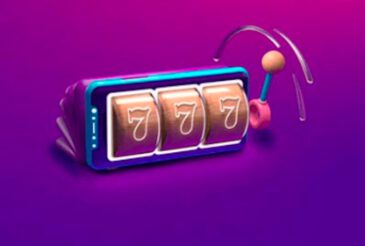
CONTENT AND QUICK NAVIGATION MENU
Blackjack is one of the most popular games in any casino. It’s fast, easy to understand, and lots of fun. It also has one of the best RTP (Return to Player) of any game, usually 99.3% or above.
But did you know you can actually improve your chances of winning by applying a basic blackjack strategy? Unlike other casino games like roulette, baccarat or slots, winning at blackjack is not purely down to luck because how you play your hands makes a significant difference to the odds of winning.
In this article, we give you a basic blackjack strategy to follow. You can use the free blackjack hands chart published below to guide you on what to do at each stage of the game, but to understand more fully, keep reading. Then browse our list of real money online casinos to find one to play at.
SIMPLE BLACKJACK STRATEGY CHART
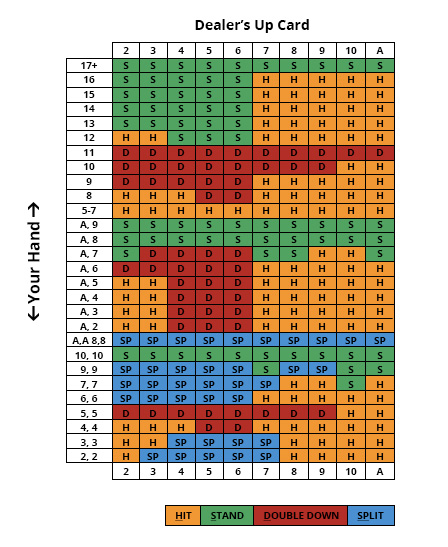
HOW TO PLAY BLACKJACK
First off, let’s recap the basic rules of the game.
Blackjack – also called pontoon – is a game played against the house. It begins with the dealer giving you two cards, plus one to themselves face-up and another face-down. Card values are as displayed except an Ace is an 11 or a 1 and picture cards are all valued at 10.
You act first by choosing to hit (ask for another card to be dealt) or stick / stand (take no more cards) and must try to get as close to a total of 21 as you can (ace is one or 11) without going over and busting. If you do, you lose your bet and the round is over.
However, if you do not bust then once you have elected to stand, the dealer now turns over their face-down card to reveal their total. In most versions of Blackjack, if it is 17 or lower, then they must take another card. If this card. takes their total to higher than 21 then they are bust and you win. If they stand on anything from 18 plus, but you have a higher total, then you win.
In short, the dealer always wins if you bust or if their total is higher than yours.
Payouts in the base game are 1:1, so if you bet $5 on a hand and win, you get a total of $10 back (your original bet and $5 in winnings). If you are lucky enough to be dealt Blackjack (an Ace and a 10 or picture card) then you get paid 3:2.
If you and the dealer draw – the same total – then this is referred to as a push and your stake is returned.
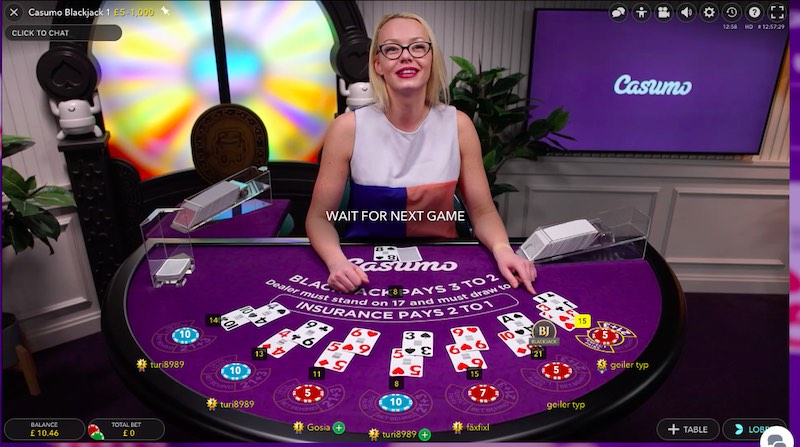
BASIC BLACKJACK STRATEGIES
The game, as you can see, is straightforward. It comes with a house edge of just over 2%, but you can bring this down to a wafer-thin 0.5% by applying some winning strategy.
All Blackjack strategies come down to simple decisions on when to hit and when to stand based on the probability of your hand and the dealer’s hand. Our basic strategy chart shows you what to do depending on what your cards show and what the dealer’s up card shows. To understand each action in the chart, you should consider the power of 10s in the game.
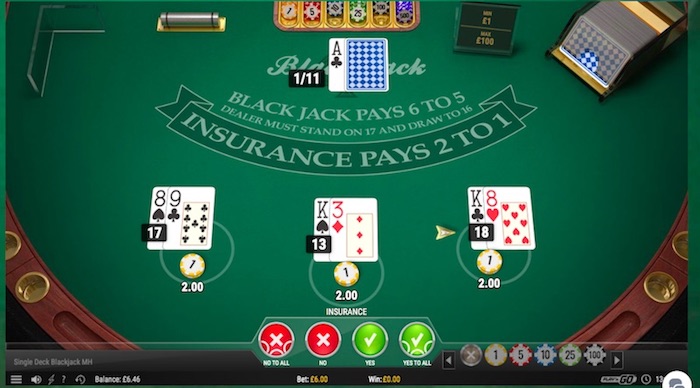
UNDERSTANDING THE POWER OF TENS
Crucial to winning more often in Blackjack is understanding probability. You need to be able to apply some basics rules to figure out how likely the next card is to make you bust or too short of 21 to stick, but with a riskier next card that could take you over that magic number.
One way to do this is to understand the power of the 10s!
In blackjack, every jack, queen, and king are valued at ten, meaning that in every 52-card pack, there are 16 cards valued at ten – that’s around 30% of the pack. With this understanding, you can make a judgement on the likelihood that the dealer’s face down card is a 10 and start to second guess the strength of their hand.
Now, you have an advantage over the unwary player. You can now play your own hand based on what you assume the dealer’s total is.
Now let’s see how we can apply this understanding to our actions in the game.
DEALER LOOKS WEAK
If the dealer has a low face-up card like a three, four, five, or six, you should assume that their down card is a 10, giving them a vulnerable total of 13-16. In this case, they would need to take a third card and likely bust. With this prediction, you can now stand with your two cards no matter what you hold, even on 12 or 13. Naturally, you can take another card risk-free on 11 or under since you cannot bust.
When the dealer is weak, you can also widen the number of hands you would consider doubling down or splitting with more pairs. You can then stand and have twice as much money on the table when the dealer busts.
DEALER LOOKS STRONG
When the dealer has a strong face-up card, like an eight, nine, or 10, you must assume that his down card is a 10, giving a strong total of 18-20. When this happens, you need to be more aggressive with your own hand, taking another card to try and inch your way closer to 21.
There is no point in doubling down with anything weaker than 11 when the dealer shows a 10.
OTHER TIPS TO MAXIMISE BLACKJACK PROFIT
Now that you understand the importance of tens, you can adopt further strategy tips to improve your blackjack performance.
TIME TO DOUBLE DOWN
You will often hear about Doubling Down in Blackjack. This is a decision you can make when the cards have been dealt. If you Double Down they your bet is doubled but ONLY ONE MORE card is dealt.
So, if your total once the first cards are dealt is 11 then you should ALWAYS Double Down. There is a reasonable chance here of getting a 10 or a 9 to take you to 21 or 20. If you win now, then the house pays out the odds on your increased stake.
Another situation in which it makes sense to Double Down is when your starting hand is close to 11 and the dealer’s up card is low – say 6 or less. This gives a good chance that the dealer will get a low teen total and then have to keep drawing, potentially going bust, whilst you will have a high teens total, even 20 or 21.
DO NOT PLAY SIDE BETS
You will be offered side bets whenever you play at a real casino or at an online casino. You might be tempted to place extra money on Perfect Pairs or 21 + 3. Side bets add an extra layer of fun to blackjack, and you can win a handsome payout if you get lucky.
But the unfortunate thing about all side bet games is that they are a losing proposition and will cost you money in the long term. So, don’t be tempted by the lure of side bet riches.
SPLIT ACES BUT NEVER SPLIT TENS
A common mistake made by new blackjack players is looking down at a nice pair of tens and then splitting. By doubling their stake, they get to split the two tens into two hands. It might be tempting to think you can now make two winning hands – and that may well be the case.
However, with two tens, you likely have a winning hand already, so why risk losing that profit?
This is true of Tens, but not of Aces. You should ALWAYS split two Aces because it gives you two more good chances to finish with two Blackjacks or close.
DO NOT ACCEPT INSURANCE
When the dealer’s upcard is an ace, they will offer you insurance, in case their down card is a ten, giving them a blackjack, which beats all your hands. Insurance is tempting because if the dealer does make blackjack, you won’t lose all your stake.
Unfortunately, just like with side bets, taking insurance is a losing proposition. Statistically, you will waste more money than you win with insurance in the long term.
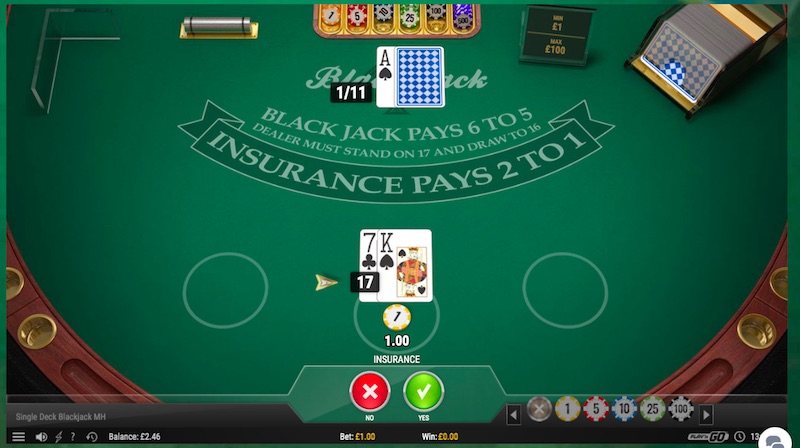
BET WISE AMOUNTS
Part of a solid blackjack strategy is betting within your means. If your stakes are too high for the money in your account, then you might quickly go bust. However, if you play for small enough stakes, you can soak up a losing streak and remain in the game without any issues.
DO NOT CHASES LOSSES
If you are on a losing session – and they do happen – then it’s probably best to walk away and come back to play with a clear head another time. Chasing losses can mean you bet more than you can afford, and you might not make clever strategic decisions that could mean you lose even more.
REMEMBER THAT HOUSE EDGE
Having read this guide, you should now be in with a better chance of winning at blackjack. But always remember that, even with a thin house edge of 0.5%, you are still expected to lose in the long term (50 cents in every $100 wagered).
That’s why it’s always a good idea to get up and leave the table if you are on a winning session. It’s the only way to lock in your profit.



